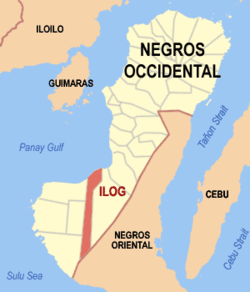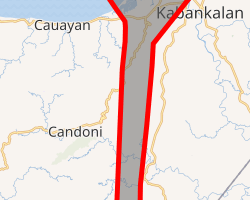Ilog, Negros Occidental
Ilog, officially the Municipality of Ilog, is a 2nd class municipality in the province of Negros Occidental, Philippines. According to the 2015 census, it has a population of 57,389 people.[3]
Ilog | |
|---|---|
| Municipality of Ilog | |
 Map of Negros Occidental with Ilog highlighted | |
OpenStreetMap 
| |
.svg.png) Ilog Location within the Philippines | |
| Coordinates: 10°02′N 122°46′E | |
| Country | |
| Region | Western Visayas (Region VI) |
| Province | Negros Occidental |
| District | 6th district of Negros Occidental |
| Barangays | 15 (see Barangays) |
| Government | |
| • Type | Sangguniang Bayan |
| • Mayor | John Paul K. Alvarez |
| • Vice Mayor | Genaro Rafael K. Alvarez |
| • Congressman | Genaro M. Alvarez Jr. |
| • Electorate | 35,834 voters (2019) |
| Area | |
| • Total | 281.70 km2 (108.76 sq mi) |
| Population (2015 census)[3] | |
| • Total | 57,389 |
| • Density | 200/km2 (530/sq mi) |
| • Households | 12,698 |
| Economy | |
| • Income class | 2nd municipal income class |
| • Poverty incidence | 19.18% (2015)[4] |
| • Revenue (₱) | 137,460,895.53 (2016) |
| Time zone | UTC+8 (PST) |
| ZIP code | 6109 |
| PSGC | |
| IDD : area code | +63 (0)34 |
| Climate type | tropical climate |
| Native languages | Hiligaynon Tagalog |
Founded by the Augustinian friars Gerónimo Marín and Francisco Bustos on May 16, 1584, it was the first capital of the historical military district/province of Negros in the late 18th century. The name Ilog (or Ylog, Tagalog for "river") was recommended by a Tagalog guide of the Spaniards because the place was entirely surrounded by the longest river on the whole Negros Island, the Hilabangan River. The first inhabitants of Ilog are mostly migrants from Panay island.
Barangays
Ilog is politically subdivided into 15 barangays.
Climate
| Climate data for Ilog, Negros Occidental | |||||||||||||
|---|---|---|---|---|---|---|---|---|---|---|---|---|---|
| Month | Jan | Feb | Mar | Apr | May | Jun | Jul | Aug | Sep | Oct | Nov | Dec | Year |
| Average high °C (°F) | 30 (86) |
31 (88) |
32 (90) |
33 (91) |
32 (90) |
30 (86) |
29 (84) |
29 (84) |
29 (84) |
29 (84) |
30 (86) |
30 (86) |
30 (87) |
| Average low °C (°F) | 22 (72) |
22 (72) |
22 (72) |
24 (75) |
25 (77) |
25 (77) |
25 (77) |
24 (75) |
24 (75) |
24 (75) |
23 (73) |
23 (73) |
24 (74) |
| Average precipitation mm (inches) | 38 (1.5) |
29 (1.1) |
55 (2.2) |
65 (2.6) |
141 (5.6) |
210 (8.3) |
212 (8.3) |
176 (6.9) |
180 (7.1) |
180 (7.1) |
130 (5.1) |
70 (2.8) |
1,486 (58.6) |
| Average rainy days | 9.0 | 7.2 | 11.1 | 13.5 | 25.6 | 28.4 | 28.9 | 27.3 | 26.9 | 27.7 | 21.8 | 13.8 | 241.2 |
| Source: Meteoblue [5] | |||||||||||||
Demographics
| Year | Pop. | ±% p.a. |
|---|---|---|
| 1903 | 10,626 | — |
| 1918 | 14,023 | +1.87% |
| 1939 | 20,957 | +1.93% |
| 1948 | 21,645 | +0.36% |
| 1960 | 24,455 | +1.02% |
| 1970 | 30,573 | +2.26% |
| 1975 | 34,977 | +2.74% |
| 1980 | 38,956 | +2.18% |
| 1990 | 46,599 | +1.81% |
| 1995 | 43,905 | −1.11% |
| 2000 | 46,525 | +1.25% |
| 2007 | 53,460 | +1.93% |
| 2010 | 54,423 | +0.65% |
| 2015 | 57,389 | +1.02% |
| Source: Philippine Statistics Authority[3][6][7][8] | ||
Hiligaynon is the major language of the city, with differences in tone and accent from the Hiligaynon used in Metro Bacolod. Filipino and English are widely taught.
Tourism
The Kisi-Kisi Festival is celebrated every 25 March. “Kisi-kisi” is a Hiligaynon term for the fast movement of crustaceans such as fish, prawns, crabs and shrimps that is abundant in the municipality. The main attraction of the festival is the Kisi-Kisi streetdancing parade competition among barangays that pays tribute to its rich marine resources. The town fiesta also honors the Señor Santo Niño as their patron saint, that is why, before the dance parade a re-enactment of Sinulog is staged to show how their village was saved from the Moro pirates. Another exciting event to look forward during the opening day of the Kisi-Kisi Festival is the "eat-all-you-can oysters" (referred by tourists as Ilog Talaba Festival) which is open to all visitors. Freshly steamed oysters are served on a long bamboo table for those who would like to savor the seafood. Kisi-Kisi was started by Mark G. Vargas to help Ilog's tourism.
References
- "Municipality". Quezon City, Philippines: Department of the Interior and Local Government. Retrieved 31 May 2013.
- "Province:". PSGC Interactive. Quezon City, Philippines: Philippine Statistics Authority. Retrieved 12 November 2016.
- Census of Population (2015). "Region VI (Western Visayas)". Total Population by Province, City, Municipality and Barangay. PSA. Retrieved 20 June 2016.
- "PSA releases the 2015 Municipal and City Level Poverty Estimates". Quezon City, Philippines. Retrieved 12 October 2019.
- "Ilog: Average Temperatures and Rainfall". Meteoblue. Retrieved 7 May 2020.
- Census of Population and Housing (2010). "Region VI (Western Visayas)". Total Population by Province, City, Municipality and Barangay. NSO. Retrieved 29 June 2016.
- Censuses of Population (1903–2007). "Region VI (Western Visayas)". Table 1. Population Enumerated in Various Censuses by Province/Highly Urbanized City: 1903 to 2007. NSO.
- "Province of". Municipality Population Data. Local Water Utilities Administration Research Division. Retrieved 17 December 2016.
External links
- Ilog Profile at PhilAtlas.com
- Philippine Standard Geographic Code
- Philippine Census Information
- Local Governance Performance Management System